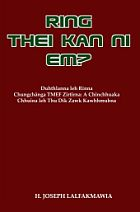Dr. R. Lalrempuia leh a thawhpuite, tuna School of Chemistry and Chemical Biology, University College Dublin Belfield, Dublin 4 (Ireland) a Post-Doctoral ti mek chuan a research tih mek ah hlawhtlinna ropui tak chang in tui (H2O) chu a phel darh a. He a thil hmuh chhuah hi khawvela original research paper pubish theihna tha ber (Chemistry bikah) Angewante Chemie (impact factor hi 12 vel a ni) ah an chhuah a ni.
Dr R. Lalrempuia hian North Eastern Hill University (NEHU) atangin PhD tha takin a zo a. Doctorate dergree nei tura a beih chhung hian international journal ah paper pawh 15 vel lai a publish hman a ni. PhD a zawh hnu hian Spain (Zaragoza) ah Post Doc hi a ti phawt a, hetah pawh hian paper tha tak tak a publish nghe nghe. Spain a Post Doc a tih zawh hnu in Ireland ah Post Doc ti turin a kal leh a, a thawhrimna leh a tumruhna avangin he hlawhtlinna ropui tak hi a chang ta a ni.
Tui phel darh chu eng nge a that na:
Mizo pa, thingtlang kilkhawr ber a awm pawn tui pawimawh zia chu an hai hauh lovang le. Mihring nunna hnar ber te zing ami a ni ti pawh kan hria ang. Tunlai khawvel ah phei chuan a pawimawhna a zual tial tial emaw tih mai tur a ni. Tui hi hydrogen pahnih leh oxygen atom pakhat in an siam a ni a. Thil nungte tana Oxygen pawimawhzia chu kan hre awm e. Hydrogen pawh hi energy source tha ber a ni kan ti thei ang (Hydrogen bomb chak zia atangin kan ngaihruat thiam awm e, atom bomb hi a kep a ni). Tunlai khawvela Chemist ropui tak tak ten an thil tih tum ber pawh tui phel darh a, hydrogen lak chhuah hi a ni reng a.
Tui phel darh hi method chi khat electrolysis an tih hmangin a tih theih a, mahse a energy hman hi energy a pekchhuah aia a tam zawk avangin energy source atan chuan hman tlak a ni lo. Chuvang chuan, room temperature ah, catalyst (chemical reaction tichak nan emaw, a chak lutuk tur timuangtu) man to lutuk lo hmang a tui phel darh hi mithiam te inelna ber pakhat a ni a. Chung mithiam tak takte zingah Mizo tlangval a tel hi a ropui in a chhuanawm tak zet zet a ni. A catalyst hman hi Iridium complexes a ni a, an hmuhchhuah tawh zingah chuan active ber a ni nghe nghe.
An paper publish phek khatna lek kan tarlang ang e:
Water Oxidation Catalyzed by Strong Carbene-Type Donor-Ligand Complexes of Iridium**
Ralte Lalrempuia, Neal D. McDaniel, Helge Muller-Bunz, Stefan Bernhard,* and
Martin Albrecht*
In memory of Fiona O’Reilly
Production of energy from renewable sources has recently become a pressing challenge in energy-related research.[1] The splitting of water into oxygen and hydrogen, inspired by nature’s use of water and sunlight as environmentally abundant feedstocks, constitutes a particularly attractive approach towards addressing this issue. In nature, photosynthetic water fixation and splitting is a delicately balanced process, overcoming the energetic barrier of O-H bond cleavage and O-O bond formation by a stunning reaction cascade.[2] The complexity of the photosynthetic machinery requires alternative approaches for artificial photosynthesis,[3] especially for the water-oxidation sequence.[4] High redoxflexibility of the active center constitutes a key element in the design of synthetic complexes for water oxidation, since the formation of O2 from H2O requires the transfer of four electrons. Apart from a number of heterogeneous systems,[5] ruthenium complexes, suggested to be oxidizes from RuII to RuVI have been successfully developed for the catalytic splitting of water.[6] Ruthenium centers in bi- and tetrametallic complexes were thought to work synergistically and hence require only oxidation to RuIV and RuIII, respectively, to provide the four electrons for O2 generation.[7] Complementary to these approaches, bis(cyclometalated) iridium(III) complexes[8] and cobalt-based tetrametallic systems[9] were shown to be active in water oxidation. The photochemical properties of these complexes allowed light to be employed to induce charge separation and subsequent water oxidation, thus mimicking the photosynthetic system very closely. Most recently, cyclometalated iridium(III) cyclopentadienyl complexes were shown to exhibit excellent activity in electrochemically induced water oxidation.[10]
Owing to the multistep redox processes involved in water oxidation, we considered abnormally bound N-heterocyclic carbenes to be advantageous spectator ligands. Abnormal carbenes, that is, formally neutral carbenes that lack a neutral resonance structure, have large contributions from zwitterionic resonance forms,[11] which may assist in stabilizing different metal oxidation states when coordinated to an appropriate transition metal. In addition, the ligands may serve as a transient reservoir of both positive and negative charge, thus providing synergistic effects similar to those observed in bi- and multimetallic complexes.[7] Based on these rationales, combined with the synthetic versatility of triazoles as potential carbene precursors,[12] we concentrated our initial efforts on the metalation of pyridinium-functionalized triazolium salt 1 (Scheme 1). This salt is readily available through copper-catalyzed [2+3] cycloaddition (“click chemistry”)[13] starting from commercially available 2-ethynylpyridine and benzylazide generated from NaN3 and BnBr, and subsequent methylation with MeOTf (OTf=trifluoromethylsulfonate). Metalation with [{Cp*IrCl2}2] (Cp*=C5Me5) induced double C-H bond activation to give the C,C-bidentate complexes 2 and 3 (Scheme 1).[14] Complex 2 comprises two different abnormally bound N-heterocyclic carbene ligands, that is, a triazolylidene and a 3-pyridylidene, while complex 3 features a rare[15] ylide bonding mode of the pyridinium ligand precursor, along with the abnormal triazolylidene. Complex 2 could be separated from the reaction mixture by virtue of its insolubility in CH2Cl2. The CH2Cl2-soluble fraction comprised several species containing a Cp*Ir fragment, as evidenced by the various singlets in the 1H NMR spectrum around d=1.9 ppm. Upon heating this mixture under vacuum, complex 3 formed in moderate yield. Notably, complex 2 did not undergo a thermally induced isomerization
to yield complex 3 under identical conditions, but instead decomposed. Hence the pyridylidene bonding mode in 2 is not an intermediate on the route to the ylide complex 3. More likely, complexes 2 and 3 share a common, monodentate triazolylidene iridium intermediate, which may then undergo C(sp2)-H or C(sp3)-H bond activation and cyclometalation.[16]
Hriat belh duh tan hetah hian a en theih e:
https://onlinelibrary.wiley.com/doi/10.1002/anie.201005260/abstract
Similar Posts:
- Solar energy & Mizoram
- James Bond: Quantum of Solace
- Thlarau Khawvel
- India rama Green Energy School hmasaber Pondicherry Univ ah
- La thlir duh an awm takin.






 ava har tak… kei chu ka failed...
ava har tak… kei chu ka failed...


January 22nd, 2011 at 9:07 pm
dar 9 a rih tawh, tui phel darh lo in pawlh dal nan hmang tawh tur….
Gudnite all and happy weekend
Report this comment
January 22nd, 2011 at 9:08 pm
Eng atan nge maw tui chu an lo phel darh vel le? A kuthleithlak lutuk em mai Kan tui in tur zawng zawng hi an lo phel darh vek a nih phei chuan kan kut chi lo hawi reng mai dawn asin
Kan tui in tur zawng zawng hi an lo phel darh vek a nih phei chuan kan kut chi lo hawi reng mai dawn asin 
@lrpa

Report this comment
January 22nd, 2011 at 9:09 pm
Nichin khan tui kan phel darh lova kan pawlh dal..


Lrpa Mizo tihmingthatu nizel ang che..
Report this comment
January 22nd, 2011 at 9:10 pm
Kawlhawk..nia, phel darh (splitting) hi tun hma deuh kha chuan an hmang a,mahse chemically in a dikfumfe chiah lo a, oxidize kan ti ta zawk ani, a reverse chu reduce ani a,hei hi a pawimawh mah mah zawk..a chhan chu Alchemy sawi ang khian energy lam a hawi zawk….
Hmeichhe phelh lam hi chu nuam ka tih zawng tur tak anih ka ring! hehe
Report this comment
January 22nd, 2011 at 9:16 pm
zualtea hi “Gudnite all…” a tih hnu hian, vawi 5 vel a rawn lang leh ziah an ti.
Tui hi ka phel darh thiam ve maithei… mahse, Uaiin tihpun nan ka la mamawh zawk tlat
Report this comment
January 22nd, 2011 at 9:22 pm
Irpa @104, Ka han fiamthu hlut a, i kal zelna turah thinlung takin duhsakna ka hlan mawlh2 a che. I hlawhtlin lawm nan, ka neihchhun – hei te hi
Ka han fiamthu hlut a, i kal zelna turah thinlung takin duhsakna ka hlan mawlh2 a che. I hlawhtlin lawm nan, ka neihchhun – hei te hi 
Report this comment
January 22nd, 2011 at 10:07 pm
alchemist an nula lam han ngaihtuah rih lo phawt mai ila a tih hian ka nuih a100 trep

Chu indian ocean hi lei thei ni ila, future ah chuan trillionaire na tham nih dawn chu, sum intuak ila tha ang a!
Report this comment
January 22nd, 2011 at 10:09 pm
LRPA I ropui e mi(sual) zinga hetiang ang khawvel miropui zinga hming ziah lan phak i lo awm ve rnghi ka chhuang a che.
Mizote ti hmingthatu chawimawi in awm mawlh ang che.
Siamtu Khuanuin thiamna mihringte a pek hmang tangkai thei a mi taima te hi in ropui in chawimawi in phu ani.







I thiamna te hi Chunglam malsawmnain ti pung zel ang che.
Report this comment
January 22nd, 2011 at 10:19 pm
@lrp: I ngaihsanawmin i chhuanawm hle mai. Mizo-te tihmingthatu ni zel turin ka duhsak a che.
Report this comment
January 22nd, 2011 at 11:14 pm
https://en.wikipedia.org/wiki/Water_splitting
Report this comment
January 23rd, 2011 at 12:52 am
Lrpa chu i lo chhuanawm hle mai, kan ram leh hnam tihmingthatu ni zel ang che.
Tui phel darh tur kan ngah theih nan Mizoram ah hi chuan water resources lamah tran lak a ngai hle thung a nih hi.
Report this comment
January 23rd, 2011 at 1:23 am
lrpa chu ka va ngaisang bawn let thuai thuai tak em! Ka duhsakna a bawm bawmin ka hlan a che.


Report this comment
January 23rd, 2011 at 1:34 am
Tui lo phel darh te chu ah! A hman thlak em mai a(h)
@lrpa . .Rajnikanth I va dah nil deuh chu ve!
Report this comment
January 23rd, 2011 at 6:27 am
Phek thar keu pahin phel darh ang.
@lrpa: In phel darh hnu hian in vuah pum leh thei em?
Report this comment
January 23rd, 2011 at 6:33 am
lrpa chu hydrogen lei tur atam nen nen
 Tak2 a han tang sauh2 rawh khai…Spain lama i kalna turah pawh tluang takin
Tak2 a han tang sauh2 rawh khai…Spain lama i kalna turah pawh tluang takin 

Report this comment